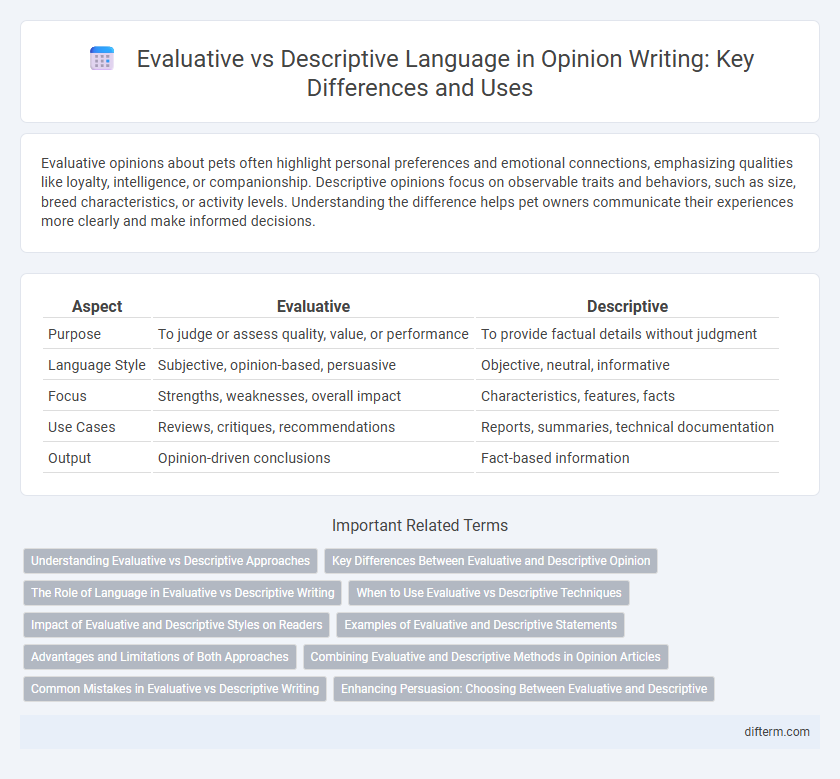Evaluative opinions about pets often highlight personal preferences and emotional connections, emphasizing qualities like loyalty, intelligence, or companionship. Descriptive opinions focus on observable traits and behaviors, such as size, breed characteristics, or activity levels. Understanding the difference helps pet owners communicate their experiences more clearly and make informed decisions.
Table of Comparison
| Aspect | Evaluative | Descriptive |
|---|---|---|
| Purpose | To judge or assess quality, value, or performance | To provide factual details without judgment |
| Language Style | Subjective, opinion-based, persuasive | Objective, neutral, informative |
| Focus | Strengths, weaknesses, overall impact | Characteristics, features, facts |
| Use Cases | Reviews, critiques, recommendations | Reports, summaries, technical documentation |
| Output | Opinion-driven conclusions | Fact-based information |
Understanding Evaluative vs Descriptive Approaches
Evaluative approaches emphasize judgment and value, offering critical insights into quality, effectiveness, or impact, which helps in decision-making processes. Descriptive approaches focus on detailing characteristics, features, or facts without assigning value, providing a clear, unbiased representation of the subject. Understanding the distinction between evaluative and descriptive methods enhances analytical skills by balancing objective information with subjective assessment.
Key Differences Between Evaluative and Descriptive Opinion
Evaluative opinions judge the value, quality, or significance of a subject based on criteria and personal perspective, often including praise or criticism. Descriptive opinions provide factual observations or detailed accounts without assigning judgment, focusing on what is rather than what ought to be. The key difference lies in evaluative opinions expressing subjective assessment, whereas descriptive opinions remain objective and informative.
The Role of Language in Evaluative vs Descriptive Writing
Evaluative writing employs language that conveys judgment, emphasizing subjective interpretation and persuasive tone, while descriptive writing focuses on objective detail and sensory information to depict reality accurately. The choice of adjectives, adverbs, and modal verbs in evaluative texts shapes readers' attitudes, contrasting with the neutral and precise vocabulary that characterizes descriptive language. Understanding these linguistic distinctions is crucial for effectively communicating intent and influencing audience perception within different writing contexts.
When to Use Evaluative vs Descriptive Techniques
Evaluative techniques are best used when assessing quality, effectiveness, or impact, providing subjective judgment supported by evidence. Descriptive techniques focus on objectively detailing features, characteristics, or processes without judgment, suitable for presenting factual information. Choosing between evaluative and descriptive depends on the goal: critique and recommendation require evaluation, while explanation and documentation call for description.
Impact of Evaluative and Descriptive Styles on Readers
Evaluative writing shapes readers' perceptions by conveying judgments and influencing emotional responses, making content more persuasive and engaging. Descriptive writing provides objective, detailed information that enables readers to form their own opinions without bias. Combining evaluative and descriptive styles enhances comprehension while guiding readers toward informed conclusions.
Examples of Evaluative and Descriptive Statements
Evaluative statements express judgments or opinions, such as "The movie was captivating and well-acted," while descriptive statements provide objective facts, like "The movie lasts two hours and stars actor X." Examples highlight the difference; an evaluative phrase may praise the plot's creativity, whereas a descriptive one details the plot's sequence without judgment. Understanding this distinction improves clarity in communication, enhancing the effectiveness of feedback or analysis.
Advantages and Limitations of Both Approaches
Evaluative approaches offer the advantage of providing critical judgments that help in decision-making and prioritizing options but may introduce bias due to subjective perspectives. Descriptive methods excel in presenting unbiased, factual information that ensures clarity and accuracy, yet they often lack the depth needed for interpretive insights. Balancing both approaches can maximize understanding by combining objective details with informed evaluation, although the challenge remains in integrating subjective and objective elements effectively.
Combining Evaluative and Descriptive Methods in Opinion Articles
Combining evaluative and descriptive methods in opinion articles enhances clarity and persuasive power by providing both a detailed account of facts and a critical assessment of their implications. Descriptive elements offer readers a clear understanding of the subject, while evaluative commentary introduces nuanced judgments that engage and inform the audience. This hybrid approach strengthens the article's credibility and fosters a deeper connection with readers by balancing objective reporting with insightful analysis.
Common Mistakes in Evaluative vs Descriptive Writing
Common mistakes in evaluative vs descriptive writing often involve confusing objective observation with subjective judgment, leading to biased or unsupported opinions. Writers frequently omit clear criteria for evaluation, making arguments less persuasive and harder to validate. Avoiding vague language and ensuring a balanced approach improves the accuracy and credibility of both evaluative and descriptive texts.
Enhancing Persuasion: Choosing Between Evaluative and Descriptive
Evaluative language strengthens persuasion by expressing judgments that appeal to emotions and values, making arguments more compelling. Descriptive language provides clear, objective details that build credibility and trust through factual accuracy. Combining evaluative and descriptive elements strategically enhances overall effectiveness by engaging both logic and sentiment in communication.
evaluative vs descriptive Infographic

 difterm.com
difterm.com